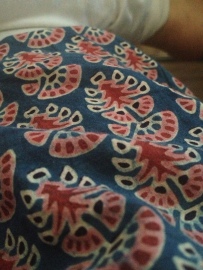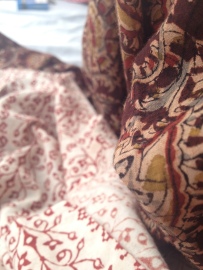The salwar kameez is a tunic, pants and scarf outfit that is worn by a large number of women in India. With the exception of the younger generation in big cities like Bangalore, if the women aren’t wearing saris then they are wearing a salwar.
The suit is worn throughout India, Pakistan, Bangladesh and Afghanistan, and is thought to have originated during the Mongol rule of the area. It is incredibly comfortable in the heat, and very modest.
The suit consists of three different items of clothing:
TOP
Kurta: A tunic with slits on the side to your hips, and can be worn long (shin/knee length) or short (thigh length). The sleeves also vary – from sleeveless, to short sleeve, elbow length or full length sleeve.
Anarkali: A dress-like top, which has a reasonably tight/fitted bodice and then a flared knee/shin length skirt (which is sewn from multiple panels depending on the region it originates from: sometimes as few as 8, or as many as 80.
PANTS
Churidar: similar to leggings, but more loose fitting and longer, with bunching (churis) at the ankle.
Salwar: loose pants fitting pants, with a straight cut leg, ending at the ankle.
Pattiala: baggy loose pants with pleats at the top, so the pants fall like balloons over your legs.
SCARF
Dupatta: scarf/shawl worn around the neck, covering your chest and back over your shoulders. Traditionally this is a huge shawl, quite wide and long. But there is also the shorter, narrower scarf.
Now the salwar kameez can be bought as a set, or as separate items. The trick is to figure out how much colour and pattern you are comfortable with, because it can be quite extreme.
If you are diving in and creating your own ensemble, its important to remember a few rules:
- Kurtas above the knee are to be worn with loose pants (preferably pattialas)
- Anarkali and kurtas below the knee can be worn with anything, but look better with churidas
- It is easiest to start with a single coloured kurta, and then match it with pants with a pattern in a complementary colour
- The dupatta must match the pants you are wearing first, and then secondly match the kurta
- Wearing three items all with different patterns can be a disaster, so if you want that much pattern it is best to look for a pre-made set.
It can be a lot of fun experimenting with the different patterns and colours that are avaliable. However it can be very easy to end up with a lot of different items that can only be worn in one or two ways. The most productive shopping expedition I ever had was one where I had a patterned dupatta, and I found two kurta and three pairs of pants that I could wear with it. So that equates to 6 different outfits.
It is fun.





